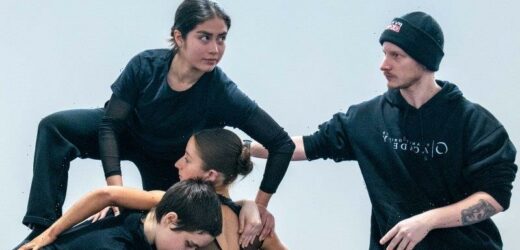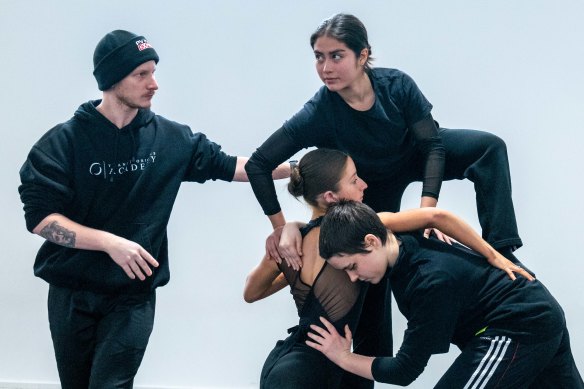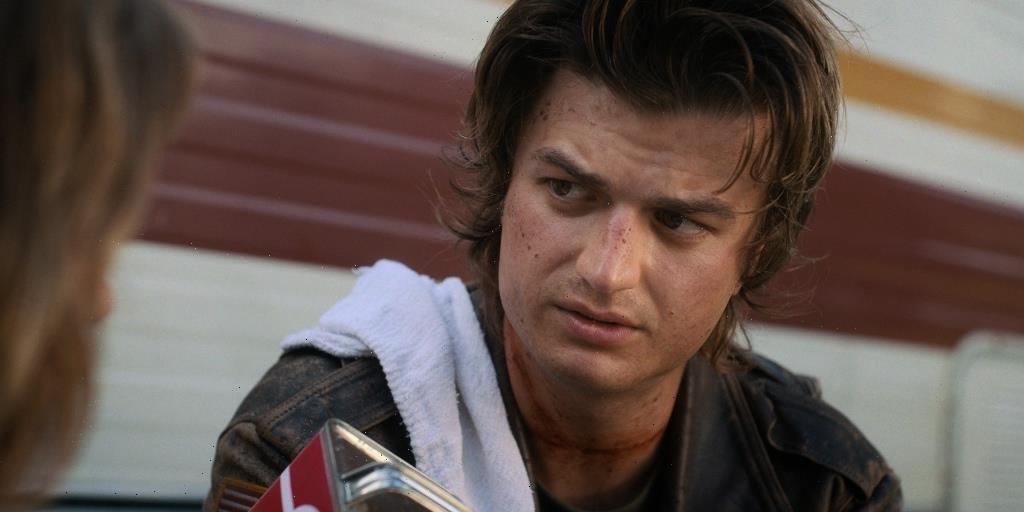Ballet training has historically been one of the most codified forms of dance practice, and as a result has not always been accessible to young dancers of broad and diverse backgrounds. Its prohibitive factors include expense, strongly gendered roots and aesthetic biases.
Jayden Hicks with students Alex, Ximena and Charlie at Transit Dance. Credit:Paul Malek
Last month, Northern School of Contemporary Dance (NSCD) in the UK axed ballet performance as an entry requirement to the school. In their official statement, NSCD defended the decision, saying they hoped it would help to “attract students from as broad and diverse a range of backgrounds as possible”.
The decision was rebuked by some who saw it as a “woke reaction” – yet this action is part of an extended conversation on redressing opportunity imbalances in the dance industry that has been taking place for some time.
Kyall Shanks is the artistic director of Yellow Wheel, a Melbourne-based dance company which specialises in young and emerging artists. When I ask what they look for in auditions, Shanks says: “Potential. Open mindedness – ours is a relaxed audition context. I’m thinking about how Yellow Wheel would benefit a young person at that point in their life, to grow as a human, a dancer, in awareness and compassion, the potential to be more them.”
Tertiary dance academies in Australia are responding to the call for diversity and inclusion in dance training.
This is at odds with what for years, tertiary dance training academies and professional dance companies may have sought in emerging dancers – but change is afoot. “Old-fashioned ideals and codified ways of teaching dance … create exclusionary boundaries,” says Shanks.
Ensuring entry requirements to tertiary dance institutions and dance companies support the diversity of applicants is an important step towards inclusivity in the dance industry, but the work is not over after the audition.
“Sometimes that which limits us is financial,” says Shanks. Yellow Wheel operates on a volunteer basis, from directors through to dancers. Inclusivity, however, can be impacted by funding availability. Differently abled dancers may need financial assistance for resources such as interpreters and accessibility requirements – as a result, they can end up being excluded from training programs and companies if funding cannot be secured.
There is also the issue of longer term structural change and equality. After an inclusive and, to borrow Shanks’ word, “loving” community of young dancers like Yellow Wheel develops, it then takes work to sustain this momentum.
Part of this work they tell me, is delegating opportunities for leadership to young members of the company and organising workshops with leading local diverse choreographers, those who have traditionally been underrepresented in the dance industry such as female, culturally and linguistically diverse, differently abled and LGBTQIA+ artists.
Another way Yellow Wheel works to break down barriers is to use expressive language rather than jargon and technical terms – during my year in Yellow Wheel in 2019 I once was in a class where Shanks described a dance move as “like a ghost on a Segway”.
Tertiary dance academies in Australia are responding to the call for diversity and inclusion in dance training. Paul Malek, artistic director of Transit Dance, says that uniforms are undergoing a redesign to be less gendered and classes are no longer gender-specific, meaning students can opt to take a range of classes from hip-hop heels to ballet to breakdance.
“People need community,” says Shanks. The more young potential dancers from diverse backgrounds see successful dancers of their identity in prestigious training institutions and dance companies, the more it will validate and encourage their aspirations.
The optimism and strength that this new wave of diverse young dancers bring to the industry, and by extension the world, is heartening.
This is certainly true of what Jacqui Maida, company member and artistic associate, experienced when she first encountered Yellow Wheel as a teen. “I wouldn’t be dancing without Yellow Wheel,” she reflects. “I came across the company when I went to see a site-specific work in a car park in 2014. I was so captivated, I returned the following night and auditioned for the company in 2017. Yellow Wheel played a huge role in me deciding to study tertiary dance.”
Since dancing with Yellow Wheel for four years and becoming artistic associate, Maida feels she has enjoyed more opportunity and growth in the dance industry than she otherwise would had she relied upon the academy and opportunities with other companies. Asked about her initial training in dance – traditional ballet – and how it compared with Yellow Wheel, she says: “I love ballet… but it has issues … With my alternative training [at Yellow Wheel] I have been lucky enough to not have to hyper-focus on those issues, but to keep a freedom in my dancing.”
The kind of dancers that youth companies like Yellow Wheel are cultivating, then, are far from the “elitism” some tertiary dance programs have been charged with and more compassionate, collaborative and self-aware than ever. “I am as proud of our alumni that have become renowned dancers in Australia’s contemporary dance scene as those that have used the compassion they have learned at Yellow Wheel in their chosen career.” Shanks reflects. “One has become a rural paramedic and I couldn’t be prouder.”
The optimism and strength that this new wave of diverse young dancers bring to the industry, and by extension the world, is heartening. The co-creation of opportunities for their success within tertiary institutions and youth dance companies is an important project in the making.
The author of this article danced with Yellow Wheel in 2019, performing in their collaboration ‘SIMULCAST’ with Chunky Move.
Yellow Wheel’s upcoming performance season will be performed in Melbourne September 1-4.
A cultural guide to going out and loving your city. Sign up to our Culture Fix newsletter here.
Most Viewed in Culture
From our partners
Source: Read Full Article



